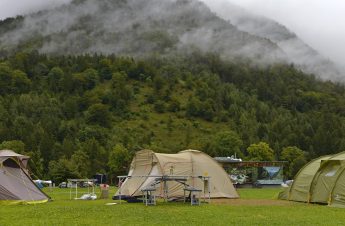Introduction
Quick Navigation
When you plan your backpacking trip, you do everything you can to prepare for a safe and enjoyable trip. However, the one thing you cannot do is to plan for the weather because that is out of your control. Therefore, that means, what do you do if you are about to leave for your camping trip and it begins to rain? Should you cancel your trip? Absolutely not! That is because there are tips you can utilize when it comes to setting up your tent in the rain. It is not ideal, but the one thing that you cannot predict is the weather. Should you cancel your trip even if you see rain in the forecast? Again, no. On that note, let’s talk about tips to utilize when it comes to setting up your tent in the rain.
The First Thing To Do Is To Set Up A Lightweight Tarp
Here is a critical tip. If it is raining, you will first set up the lightweight tarp. If you are camping in an area with plenty of trees surrounding you, you want to do this since you will risk getting wet the most with the water falling off the leaves and branches. If you do not have a tarp, then you will need to use a rainfly as either one will work. You can use some paracord if the guy lines are not long enough to set this up. The tip is easy to utilize if there are others with you, but you will want to practice doing this before camping if you are camping alone. As you know, practice makes perfect.
You Will Want To Have A Tent With Zip Out Panels
If you don’t have your tent yet, you may want to consider purchasing a tent with zip-out panels. It is easier to set those tents up in the rain than mesh tents. However, if you already have a mesh tent and prefer to use it, you need to utilize that tarp or rainfly. However, a zip-out tent is an excellent investment to make anyway, as the panels that the tent features will keep the interior dry. After attaching the rainfly, then you can remove the panels. It will be impressive to see how dry your inside of the tent is.
The only disadvantage to this is that the panels make your tent heavier, which can be a challenge if you are backpacking. However, if you take your car to the campsite, you can utilize this one. You can always find an excellent area to set your mesh tent with the rainfly too.
The Simple Solution As Well Is To Find A Great Area To Set Up The Tent
The one thing you can do to reduce your risk of getting the interior wet if you have a mesh tent, tarp, or a rainfly is to set your tent up in a good area of the campsite. The best site would be as “dry” as possible, even when raining. You will want to set your tent up on the lee side of a windbreak, such as a rocky area or an overhang. That will keep the winds low and not spread the rain around much.
The best area will also be at a higher elevation. You do not want to choose a place in a low-lying area such as a depression or a canyon floor to pitch your tent. Those areas are wetter. That means never set your tent at the bottom of a slope as that area collects water. Also, stay away from rivers or any body of water because of the risk of flooding.
Wear Waterproof Hiking Boots While Setting Up Your Tent In The Rain
There is not only the risk of the tent’s interior getting wet while setting it up in the rain, but you will get very uncomfortable if you get wet too. Of course, that goes for your feet which is why you’ll want to wear waterproof hiking boots. That way, your feet won’t get wet or only experience slight dampness. However, if there is a torrential downpour while you set your tent up, you will want to put trash bags over your boots and tie them up with duct tape around your lower legs. You can also go for waders or gaiters. That is a good idea if you set up your tent on a dry day, but the ground is wet because of a previous rainstorm.
Don’t Forget A Waterproof Bivvy
If you have to set your tent up in a torrential downpour, that is when the bivvy will come in handy. The bivvy is also a bivouac sack as it gives backpackers lightweight emergency weather protection as they are highly durable and waterproof. Additionally, they will keep you warm by reflecting most of your body heat to you. The inside of your tent will inevitably get wet when there is a torrential downpour, and when it happens, you can set the bivvy sack inside! Many campers find that the bivvy is an essential item to bring on their camping trip for this reason. No one can predict the weather, even if rain is forecast. The weather people may not always correctly predict a torrential downpour even if they say rain is on the way.
Always Remember To Bring A Large Sponge
Even if you are careful when setting up your tent in the rain, the inside can still get wet. If you don’t have a bivvy or you don’t want to use it right away, you can take a large sponge with you to sop the water out. That item should be one that every backpacker should bring with them on their camping trip. If only a little bit of water falls into the tent, you can use dry micro-towels to wipe any water. You will want to bring many of those too because you will need those for yourself, which will not do with the weather.
Conclusion
In an ideal world, you would go camping‘ when the weather is perfectly dry. However, rain does not have a schedule, and weather forecasters can get their predictions wrong. Therefore, it may start raining on the day you plan to go camping. What do you do in that case? Cancel your backpacking trip? No, because you can utilize tips on staying dry and keeping the inside of your tent dry while setting it up in the rain. The best thing to do is to prepare yourself for anything to happen on your camping trip, which includes setting up your tent on a rainy day.

